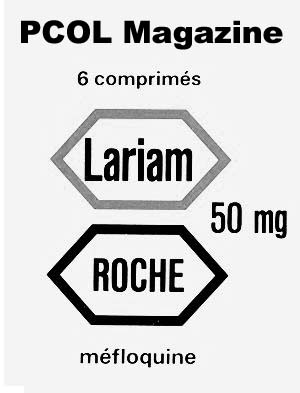
Later that year, the Army Surgeon General’s Office -- the department directly responsible for the use of Lariam -- issued its report. I have to say it was the day I lost what remained of my naivete about government and drug safety and the mainstream media’s ability to connect even two dots with a straight line. The report concluded there was no cluster of Lariam-related murder-suicides at Fort Bragg. They did this by expanding the parameters of the “cluster” they were examining. Besides the three Special Operations murder-suicides, there had been two other murders at Fort Bragg that summer of 2002 -- a cook stabbed his wife and set her trailer on fire in a jealous rage, and a wife got her boyfriend to murder her Army major-husband for the insurance money. The report lumped these in with the three Special Operations murder-suicides -- the ones people were concerned about -- and said, see, only three of these five had taken Lariam, so, voila, no cluster.
Dan Olmstead writes: The Lariam Coverup
Drugs, Death and the Manufacture of Doubt
Lariam By Dan Olmsted
I hope regular readers of this site will indulge a fairly extended incursion into a topic that, on the surface, is unrelated to autism but that connects at a deep level with our point and purpose. It concerns what I would call an analogous situation, and analogies sometimes have just as much power as direct argument and evidence.
This piece is triggered by two articles written last week on The Huffington Post by Greg Mitchell, editor of Editor & Publisher magazine and nine books including “Wrong for So Long: How the Press, the Pundits -- and the President -- Failed on Iraq.” Greg is one of the really smart guys orbiting the media universe, and was among the first to raise questions about the weak and wobbly performance of the press in covering the so-called “war on terror.”
My own experience with Greg comes from something he wrote in March 2004: “My vote for Iraq reporter of the year goes to a low-profile journalist who did not cover the war itself and has never even been to Baghdad. His name is Mark Benjamin, 33, and he serves as investigations editor for United Press International out of Washington, D.C. E&P has documented his work since last autumn, and now the heavy hitters - The New York Times and The Washington Post - are following his lead, taking a long look at the forgotten American victims of the war: the injured, the traumatized, and the suicides.”
At that point, Mark and I were colleagues at UPI -- I was his editor on those stories, although we were first and foremost co-conspirators in trying to bring attention to the woeful way the military was treating its soldiers and veterans. We had already been working together a couple of years at that point, starting in early 2002 with an investigative series on an anti-malaria drug called Lariam. The Army invented it as older malaria pills were losing effectiveness during the Vietnam era, and rushed it onto the market with inadequate testing under a licensing deal with Roche. It didn’t take long for the pharmaceutical version of “sin in haste, repent at leisure” effect to appear -- by the late 1980s, severe mental problems that included suicide and aggressive behavior were showing up in the military and also in the general traveling population, which was being prescribed Lariam as the new wonder drug.
I wandered into this story in an odd but oddly powerful way -- two friends of mine took trips within a few months of each other, one to India, one to the Amazon, and returned to say that a malaria medication they’d taken had driven them crazy. I mean, really and truly crazy; psychotic; barking mad, as the Brits so vividly put it. I started reading up on this drug and found that the FDA, which approved it, and the CDC, which recommended it, and the Walter Reed Army Institute of Research, which invented it, and Roche, which manufactured it, all backed it to the hilt. The malaria surveillance officer at the CDC attributed all the carping to travel stress that the Internet had fanned into some kind of urban myth about a wonderfully safe and effective drug. (All the Peace Corps kids who claimed it drove them crazy -- well, they’re an odd, hypersensitive, idealistic bunch, he claimed.)
We weren’t buying it, and we wrote a long investigative piece for Newsday in 2002 that began:
WASHINGTON, May 21 (UPI) -- Mounting evidence suggests the anti-malaria drug Lariam -- prescribed to Peace Corps volunteers, travelers and U.S. soldiers -- has triggered mental problems so severe that in a small percentage of users it has led to the ultimate side effect: suicide.
We were right, and we were wrong: Suicide turned out NOT to be the ultimate side effect. The next month, three Special Operations soldiers who returned from Afghanistan to Fort Bragg, N.C., killed their wives and then themselves. This made big headlines -- was the war on terror and its new and stealthy nature driving our best troops over the edge? We had our own ideas, and we went down to Fort Bragg and talked to enough people to see a pretty clear pattern. These soldiers had messed-up marriages, yes, but they also had zero history of domestic violence, which almost always precedes domestic homicide. I remember standing in the back yard of one of these now-dead couples and talking to a friend of theirs who was cleaning out a shed that held fishing gear the father took on outings with his three sons (now dispersed to relatives in Ohio -- collateral damage that never gets written about). This friend said, yes, the soldier had taken Lariam and lots of it, and yes, he had been very strange since he came back -- “jacked up” was the quote I scribbled on my business card, the first overt sign that something was off kilter in these highly trained and seasoned soldiers. Other Special Ops families were talking openly about seeing similar behavior. They were concluding on their own -- no help from the Internet or prodding from the pesky press required -- that Lariam was behind the cluster of murder-suicides.
We wrote about all that -- and wrote about it, and wrote about it some more, which is what you have to do if you want to break through the Gary-Condit-Craigslist-Killer static in this media day and age. For several weeks we piled up the evidence but our story just lay there, until our far bigger competition, the Associated Press, picked it up as their own (better to be copied than ignored). Suddenly, one morning, it was everywhere. CNN was running crawls about how the drug had been linked to suicide, about internal company documents discussing that fact (we had unearthed them in our original investigation, including a section titled Special Review: Lariam and Suicide, Suicide Attempt and Suicidal Ideation), and about how the Army itself was now going to do an investigation. Wow. Attention would be paid.
But that was the problem, right there: The Army itself was going to do an investigation. The media was satisfied by this “response” and the story faded away; no one seemed to realize that the Army investigating a drug it invented, and rushed onto the market, and ordered its soldiers to take without proper warnings, might not be the most direct route to the truth. And remember, this was the summer of 2002; America had just “won” in Afghanistan in the wake of 9/11, and now the drums were beating for an invasion of Iraq before the WMD question mark turned into a mushroom cloud over Manhattan. Hoo-AH!
Later that year, the Army Surgeon General’s Office -- the department directly responsible for the use of Lariam -- issued its report. I have to say it was the day I lost what remained of my naivete about government and drug safety and the mainstream media’s ability to connect even two dots with a straight line. The report concluded there was no cluster of Lariam-related murder-suicides at Fort Bragg. They did this by expanding the parameters of the “cluster” they were examining. Besides the three Special Operations murder-suicides, there had been two other murders at Fort Bragg that summer of 2002 -- a cook stabbed his wife and set her trailer on fire in a jealous rage, and a wife got her boyfriend to murder her Army major-husband for the insurance money. The report lumped these in with the three Special Operations murder-suicides -- the ones people were concerned about -- and said, see, only three of these five had taken Lariam, so, voila, no cluster.
This was jaw-droppingly, self-evidently bogus and cynical, but no one outside the world of those who had taken the drug and knew its effects (and a gutsy group called Lariam Action USA) bothered to question it. The Army leaked its report to USA Today, which in the short space it had to “break” the story could only report the facts as offered: “An Army investigation of possible medical and behavioral causes behind a series of domestic killings and suicides at Fort Bragg, North Carolina, has ruled out the antimalaria drug Lariam, officials said. Speculation about possible explanations for the killings has run the gamut from the stress of combat to psychotic side effects from Lariam. Three of the four soldiers involved in the killings had recently returned from Afghanistan.”
What a relief -- Army rules out Lariam. On that day I felt a chill of isolation from mainstream journalism that has settled deep into my bones in the intervening years. (And I was an original editor at USA Today, which hurt even more.)
Predictably, more mayhem ensued. By the summer of 2003, we were in Iraq, and tens of thousands of U.S. soldiers were taking Lariam (even though the CDC didn’t recommend it for Iraq -- there was no malaria risk and other, older, safer drugs worked just as well). And, guess what, there was an immediate spike in the Army suicide rate. Once again, they did a study: “A new Army report reveals that soldiers committed suicides at elevated rates during 2003, with those deployed to Iraq and Kuwait experiencing the greatest increase.”
And once again, the Army acquitted itself. “’We have no data that indicate that Lariam was a factor in any Army suicides in Operation Iraqi Freedom and Operation Enduring Freedom (Afghanistan).’ Instead, the Army said, the deaths were linked to ‘failed personal relationships, financial crises, legal difficulties and mental problems like depression and psychosis’ -- the same factors that trigger suicide in the general public, magnified by ready access to guns.” ABL -- anything but Lariam.
Which brings us back around to Greg Mitchell, who wrote two pieces in the last week about a soldier who killed herself in Iraq in 2003. “With each new revelation on U.S. torture in Iraq, Afghanistan and Gitmo (and who, knows, probably elsewhere), I am reminded of the chilling story of Alyssa Peterson, who I have written about numerous times in the past three years but now with especially sad relevance. Appalled when ordered to take part in interrogations that, no doubt, involved what we would call torture, she refused, then killed herself a few days later, in September 2003.”
This rang a bell. I have long since tossed out boxes full of documentation about Lariam and the military (it was getting hard to get the car into the garage), but I still have the Roche internal safety reports from the 1990s where they catalog the reports of insanity, suicide and violence and pass it off as part of the decline in our social fabric. (Truly, they do! Their “Special Review” on suicides in previously well-adjusted travelers attributes the death to "the progressive break down of traditional values" and family structure, substance abuse and unemployment, not to Lariam use.)
And I still have the folder in which I kept track of those suicides in Iraq. I dug it out last night. The first page lists 21 suicides in 2003. At the top of the page is a note to myself: “Like Fort Bragg -- got caught in the headlights.” By that, I meant that just as the murder-suicide cluster at Fort Bragg threatened to expose the widespread problems the drug was causing soldiers in Afghanistan, the suicide spike the next summer in Iraq showed the same thing was happening all over again. This time, though, it was worse, if one death can ever be said to be worse than another death. This time, the Army had fair warning, the media should have been alert, and soldiers didn’t even need the drug in Iraq whereas there was a technical case for it in Afghanistan.
In that folder, I listed “OIF [Operation Iraqi Freedom] Suicides in calendar year 2003” and put a circle next to the name if they were “in L unit” -- a unit that took Lariam. Figuring this out was a tedious process -- I recall spending a good chunk of the summer of 2004 on this one task, because the Army Surgeon General had told Congress (under oath) that Lariam couldn’t possibly be a factor because only four of the suicides occurred in units that were taking it. I counted at least 11 suicides in such units -- enough to fully explain the big increase in the suicide rate. After we wrote about that, the Army had to go back and quietly “amend” the surgeon general’s sworn statement based on “more complete information.” (It was in fact another cluster-fuck, the Army manipulating epidemiology to mask malfeasance. The tactic was also evident in the case of a soldier who was airlifted out of Iraq that summer of 2003 in the midst of a complete psychotic break. He hanged himself at Walter Reed a short while later but was not counted as an Iraq war suicide; he was almost certainly a Lariam psychosis victim.)
Looking at my list now, I see the first suicide occurs on April 13, 2003, about three weeks after the invasion of Iraq. Then they really take off in June, July and August -- just when the weekly load of Lariam toxicity would have peaked (it is fat soluble and settles in your brain and has a half-life -- the amount of time it takes half the drug to leave your body -- from hell). Then there is this entry:
-- Sept. 15, Army Spc. Alyssa R. Peterson, 27, of Flagstaff Ariz. Died in Teafar, Iraq, from a non-combat weapons discharge. Assigned to C Company, 311th Military Intelligence Battalion, 101st Airborne (Air Assault), Fort Campbell, Ky.
I have the date circled. It’s impossible to be sure at this point, but I assume that means I had connected Lariam to her unit, through what process I no longer recall. Of course, even if that is correct, it doesn’t mean she actually took Lariam; even if she took it, that doesn’t mean it affected her; even if she took it and it did affect her, that didn’t mean she killed herself solely and proximately due to this drug rather than because of her concern about torture. But on that same list, I also note four other Iraq suicides in 2003 in soldiers who were either stationed at Fort Campbell or were part of the 101st Airborne Division headquartered there. In other words, it was another cluster.
This confusion is just how the Army liked it -- they kept almost no records of who took the drug, let alone which units prescribed it, completely contrary to their own written regulations. They never bothered to find out retrospectively, to say the least,, and they did everything they could to obstruct those who were trying. A classic example: Mark Benjamin and I had put in a request to determine how many veterans of the Somalia conflict -- where Lariam was first used -- had subsequently committed suicide. We put that question to the VA in the form of a Freedom of Information request. I happen to know that a conversation took place inside the VA in which the person in charge of fulfilling that FOI request asked, Do we have that information? He was told, Well, not on one piece of paper, but all we have to do is push a button and the program will spit it out. The response: Well, then, we DON’T have that information. Deny the request.
As I said, I keep seeing stories like Greg Mitchell’s attributing suicides to all kinds of triggers -- and once again, Greg is a superb journalist, mining the facts he has to work with. But those facts, as they’ve been filtered, fudged and filibustered over the past few years, may not comprise all the relevant data.
Another and more bizarre instance is a cluster of suicides among Army recruiters in Texas that recently made news and was the subject of a Congressional hearing in which Army officials declared themselves gobsmacked, absolutely shocked -- shocked. Time magazine wrote a big piece about it April 13, promoted on the cover as “The Tragic Tale of Army Recruiter Suicides.” It goes five full pages, and starts with an anecdote about an Army staff sergeant who was exhausted and demoralized by his job as a recruiter and told a colleague, “’I had such a bad, long week, it was ridiculous.’” He hung himself in his garage. Time called recruiting “perhaps the toughest, if not the most dangerous, job in the Army.”
Oh, for pity’s SAKE! What about this stray fact mentioned in the next paragraph: “Soldiers who have returned from tours in Iraq and Afghanistan now constitute 73% of recruiters, up from 38% in 2005.” In other words, many if not most recruiters for the United States Army served in areas where the Army made them take a drug that can cause severe and long-lasting (let’s call them what they are -- permanent) psychiatric problems, including suicide and aggression, and covered it up not once but twice. To review the official product label one last time:
“Mefloquine [the generic name] may cause psychiatric symptoms in a number of patients, ranging from anxiety, paranoia, and depression to hallucination and psychotic behavior. On occasions, these symptoms have been reported to continue long after mefloquine has been stopped. Rare cases of suicidal ideation and suicide have been reported though no relationship to drug administration has been confirmed.”
Note the bland phrase “a number of patients.” Believe me, if they could establish it was a SMALL number, they would say so. But they have no clue, in large part because they won’t look, and the government and media won’t make them. And maybe a link to suicide hasn’t been “confirmed,” another artful phrase, but trust me, drug manufacturers do not warn of death on official product labels unless they well know it can happen, has happened, and will happen again, and the warning is needed to protect them in any ensuing legal action.
What has happened here, in summary, is the bad guys won, and they’re still winning. Because of the cover-ups and misdirection committed by Army medical doctors -- a direct violation of their oath to put patients first and do no harm -- we find ourselves discussing how being an Army recruiter is the hardest and most dangerous job in the military, and how it’s perfectly logical to kill yourself after “a bad, long week,” and how failed personal relationships, financial crises, legal difficulties and mental problems like depression and psychosis are picking off our soldiers faster than Iraqi snipers, and how the breakdown of traditional values is causing travelers to kill themselves, and how Alyssa Peterson committed suicide because of Army torture tactics she abhorred. We’re right back where I started, when the head of malaria surveillance at the CDC said those Peace Corps volunteers were, frankly, a little weird.
Well, we’re not quite where we started. I’ve learned a little more about science and its methods since I worked on the Lariam story, and now I know why this whole episode has gone on so long: “Entia non sunt multiplicanda sine necessitate.” Allow me to translate this epigram attributed to philosopher and theologian William of Occam centuries ago:
“Entities must not be multiplied unnecessarily.” This is the law of ontological parsimony that -- allow me to translate further -- means, in essence, the simplest explanation for unusual phenomena is the one that should be studied first, and either disproven or embraced, before more complicated theories -- ones that require more facts and theories, more “entities” -- are embraced. In practice, it means that if the Army gave a drug that can cause psychosis, suicide and homicide to tens of thousands of soldiers, and those effects can persist long after they stop taking it, and we observe a pattern of psychosis, suicide and homicide in those soldiers, some of it quite persistent, we need to check that correlation out pretty carefully.
I said this is a case where the bad guys won, but I should point out the following dispatch from Stars and Stripes last month: “The Army has dropped Lariam — the drug linked to side effects including suicidal tendencies, anxiety, aggression and paranoia — as its preferred protection against malaria because doctors had inadvertently prescribed it to people who should not take it.
“Lariam, the brand name for mefloquine, should not be given to anyone with symptoms of a brain injury, depression or anxiety disorder, which describes many troops who have deployed to Iraq or Afghanistan.
“The Army’s new choice for anti-malarial protection is doxycycline, a generic antibiotic.
“’In areas where doxycycline and mefloquine are equally efficacious in preventing malaria, doxycycline is the drug of choice,’ Army Surgeon General Lt. Gen. Eric Schoomaker said in a memo dated Feb. 2.”
So no more Lariam and no one accountable -- just the death and destruction it caused our Army and the mayhem it will wreck on our veterans. Maybe Eric Shinseki, who spoke truth to power as Army chief of staff and lost his job over it before the Iraq war, and is now head of the VA, ought to check it out.
After our Lariam investigation and Mark’s stellar work on the mistreatment of Iraq vets, we went our own ways, Mark to Salon, where he continues to do the best work on veterans problems of any reporter in the country (he broke the Walter Reed story, of which The Washington Post’s Pulitzer Gold Medal investigation was derivative -- better to be copied than ignored). I took the drug angle, looking more deeply into whether the same kinds of conflicts, self-dealing and media blindness we saw with Lariam could be playing out on an even bigger and more catastrophic stage -- autism.
I’ll let you be the judge of that.











